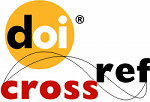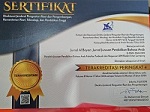Digital Material EPUB Based to Understand Tarkib: Is Flipped Classroom Effective?
Abstract
Keywords
Full Text:
PDFReferences
Aburezeq, Ibtehal Mahmoud. “The Impact of Flipped Classroom on Developing Arabic Speaking Skills.” The Asia-Pacific Education Researcher, 2019. https://doi.org/10.1007/s40299-019-00483-z.
Albahuoth, Haifa. “Effectiveness of flipped classroom in developing 11th graders’ grammatical competences in Arabic.” Interactive Learning Environments, 2020, 1–17.
Alsowat, Hamad. “An EFL Flipped Classroom Teaching Model : Effects on English Language Higher-order Thinking Skills , Student Engagement and Satisfaction.” Journal of Education And Practice 7, no. 9 (2016): 108–21.
Alwaely, S. Methods of teaching literature, rhetoric, and expression: Between theory and application. Amman: Dar Alshurooq, 2004.
Al‐Zahrani, Abdulrahman M. “From Passive to Active: The Impact of the Flipped Classroom through Social Learning Platforms on Higher Education Students’ Creative Thinking.” British Journal of Educational Technology 46, no. 6 (2015): 1133–48. https://doi.org/10.1111/bjet.12353.
Azizi, Rozika, Anwar Sa’dullah, dan Mohammad Afifulloh. “Strategi Guru Mengatasi Kesulitan Belajar Siswa Pada Mata Pelajaran Bahasa Arab Di Madrasah Tsanawiyah Yaspuri Kota Malang.” Vicratina: Jurnal Pendidikan Islam 4, no. 6 (13 Juli 2019): 102–12.
Bartalesi, Valentina, dan Barbara Leporini. “An enriched ePub eBook for screen reader users,” 375–86. Springer, 2015.
Basal, Ahmet. “The Implementation of a Flipped Classroom in Foreign Language Teaching.” Turkish Online Journal of Distance Education 16, no. 4 (Oktober 2015): 28–37.
Bergmann, Jonathan, dan Aaron Sams. Flip Your Classroom: Reach Every Student in Every Class Every Day. Washington, D.C, America: International Society for Technology in Education, 2012.
Cresswell, John W., dan J. David Cresswell. Research Design: Qualitative, Quantitative, and Mixed Methods Approaches. Sage Publication, 2017.
Delozier, Sarah J., dan Matthew G Rhodes. “Flipped Classrooms : a Review of Key Ideas and Recommendations for Practice.” Educ Psychol Rev, 2016. https://doi.org/10.1007/s10648-015-9356-9.
Evseeva, Arina, dan Anton Solozhenko. “Use of Flipped Classroom Technology in Language Learning.” Procedia - Social and Behavioral Sciences 206, no. November (2015): 205–9. https://doi.org/10.1016/j.sbspro.2015.10.006.
Fahrurrozi, Aziz. “Pembelajaran Bahasa Arab: Problematika dan Solusinya.” Arabiyat: Jurnal Pendidikan Bahasa Arab dan Kebahasaaraban 1, no. 2 (2014).
Fautch, Jessica M. “Research and Practice The flipped classroom for teaching organic chemistry in small classes : is it effective ?” Chemistry Education Research and Practice 16 (2015): 179–86. https://doi.org/10.1039/C4RP00230J.
Foldnes, Njål. “The flipped classroom and cooperative learning : Evidence from a randomised experiment.” Active Learning In Higher Education 17, no. 1 (2016): 39–49. https://doi.org/10.1177/1469787415616726.
Fuadi, Faturahman. “Analisis Kesulitan Belajar Bahasa Arab:” Al-Lisan: Jurnal Bahasa (e-Journal) 4, no. 2 (1 Agustus 2019): 161–69.
Green, Lucy Santos, Jennifer R Banas, dan Ross A Perkins, ed. The Flipped College Classroom: Conceptualized and Re-Conceptualized. Cham: SpringerInternational Publishing Switzerland, 2017.
Hasbiyati, Haning, dan K Laila. “Penerapan Media E-Book Bereksistensi EPUB untuk Meningkatkan Minat dan Hasil Belajar Siswa SMP pada Mata Pelajaran IPA.” Jurnal Pena Sains 4, no. 1 (2017): 16–21. https://doi.org/10.21107/jps.v4i1.2775.
Hung, Hsiu-ting. “Flipping the classroom for English language learners to foster active learning.” Computer Assisted Language Learning 28, no. 1 (2015): 81–96. https://doi.org/10.1080/09588221.2014.967701.
Islam, Asep Muhammad Saepul. “Faktor Demotivasi Pembelajaran Bahasa Arab Dalam Perspektif Siswa Madrasah.” Arabiyat : Jurnal Pendidikan Bahasa Arab dan Kebahasaaraban 2, no. 1 (1 Juli 2015): 1–16. https://doi.org/10.15408/a.v2i1.1511.
Islamy, M., Muhammad Amrullah, Agus Riwanda, Nuril Mufidah, Luthfiya Pusposari, dan Abdul Fattah. “Developing Social Studies Teaching Materials Based on Multimedia EPUB for The Effectiveness on Learning Outcomes,” 1:np. Slovakia: European Alliance for Innovation (EAI), 2020. https://doi.org/10.4108/eai.2-10-2018.2295460.
Jensen, Jamie L., Tyler A. Kummer, dan Patricia D. d. M. Godoy. “Improvements from a Flipped Classroom May Simply Be the Fruits of Active Learning.” CBE—Life Sciences Education 14, no. 1 (2 Maret 2015): 1–12. https://doi.org/10.1187/cbe.14-08-0129.
Kang, M, dan T Imt. “Factors of learner – instructor interaction which predict perceived learning outcomes in online learning environment.” Journal of Computer Assisted Learning 29 (2013): 292–301. https://doi.org/10.1111/jcal.12005.
Kang, Namhee. “The Comparison between Regular and Flipped Classrooms for EFL Korean Adult Learners.” Multimedia Assisted Language Learning 18, no. 3 (2015): 41–72.
Kim, Jeong-eun, dan Hyunjin Park. “Exploring Flipped Classroom Effects on Second Language Learners ’ Cognitive Processing.” Foreign Language Annals 50, no. 2 (2017): 260–84. https://doi.org/10.1111/flan.12260.
King, Alison. “From Sage on The Stage to Guide on The Side.” College Teaching 41, no. 1 (2013): 30–35.
Låg, Torstein, dan Rannveig Grom Saele. “Does the Flipped Classroom Improve Student Learning and Satisfaction ? A Systematic Review and Meta-Analysis.” AERA Open 5, no. 3 (2019): 1–17. https://doi.org/10.1177/2332858419870489.
Lai, Chiu-Lin, dan Gwo-Jen Hwang. “A Self-Regulated Flipped Classroom Approach to Improving Students’ Learning Performance in a Mathematics Course.” Computers & Education 100 (1 September 2016): 126–40. https://doi.org/10.1016/j.compedu.2016.05.006.
Lee, Jihyun, Taejung Park, dan Robert Otto Davis. “What Affects Learner Engagement in Flipped Learning And What predicts its outcomes ?” British Journal of Educational Technology 0, no. 0 (2018): 1–18. https://doi.org/10.1111/bjet.12717.
Li, Shuangjiang, dan Jitpanat Suwanthep. “Integration of flipped classroom model for EFL speaking.” International Journal of Learning and Teaching 3, no. 2 (2017): 118–23.
Mas’ud, Huzaima, dan Herman Dwi Surjono. “The Implementation of Flipped Classroom Learning Model Using Moodle To Increase Students ’ Higher Order Thinking Skills.” Journal of Educational Science and Technology 4, no. 3 (2018): 187–94.
Mcnally, Brenton, Janine Chipperfield, Pat Dorsett, Letitia Del, Fabbro Valda, Frommolt Sandra, Gregory Reddan, Anne Roiko, dan Andrea Rung. “Flipped classroom experiences : student preferences and flip strategy in a higher education context.” Higher Education 73, no. 2 (2017): 281–98. https://doi.org/10.1007/s10734-016-0014-z.
Moravec, Marin, Adrienne Williams, Nancy Aguilar-roca, dan Diane K O Dowd. “Learn before Lecture : A Strategy That Improves Learning Outcomes in a Large Introductory Biology Class.” CBE—Life Sciences Education 9 (2010): 473–81. https://doi.org/10.1187/cbe.10.
Najah, Zughrofiyatun, dan Azzah Saniyyah Maulana. “Mahârah Al-Kitâbah Learning Through Mind Mapping Strategies.” Jurnal Al Bayan: Jurnal Jurusan Pendidikan Bahasa Arab 11, no. 2 (9 Desember 2019): 340–55. https://doi.org/10.24042/albayan.v11i2.5038.
Nunan, David. Designing tasks for the communicative classroom. Cambridge: Cambridge University Press Cambridge, 2001.
Prensky, Marc. “Digital Natives, Digital Immigrants Part 2: Do They Really Think Differently?” On The hORIZON 9, no. 6 (2001): 1–9.
Reynolds, Kim D, dan Stephen G West. “A multiplist strategy for strengthening nonequivalent control group designs.” Evaluation Review 11, no. 6 (1987): 691–714.
Ridha, Muhammad, Punaji Setyosari, dan Dedi Kuswandi. “Pengaruh Flipped Mastery Classrom Terhadap Perolehan Hasil Belajar Kognitif Mahasiswa.” Jurnal Pendidikan: Teori, Penelitian, dan Pengembangan 1, no. 4 (1 April 2016): 655–61. https://doi.org/10.17977/jp.v1i4.6211.
Sadeghi Beniss, Aram Reza, dan Vahid Edalati Bazzaz. “The Impact of Pushed Output on Accuracy and Fluency of Iranian EFL Learners’ Speaking.” Iranian Journal of Language Teaching Research 2, no. 2 (Juli 2014). https://doi.org/10.30466/ijltr.2014.20413.
Şengel, Erhan. “To FLIP or Not to FLIP: Comparative Case Study in Higher Education in Turkey.” Computers in Human Behavior 64 (1 November 2016): 547–55. https://doi.org/10.1016/j.chb.2016.07.034.
Shi, Hao. “Developing E-Learning Materials for Software Development Course.” International Journal of Managing Information Technology 2, no. 2 (31 Mei 2010): 15–21. https://doi.org/10.5121/ijmit.2010.2202.
Sohrabi, Babak, dan Hamideh Iraj. “Implementing flipped classroom using digital media : A comparison of two demographically different groups perceptions.” Computers in Human Behavior 60 (2016): 514–24. https://doi.org/10.1016/j.chb.2016.02.056.
Turan, Zeynep, dan Birgul Akdag-Cimen. “Flipped classroom in English language teaching: a systematic review.” Computer Assisted Language Learning 33, no. 5–6 (3 Juli 2020): 590–606. https://doi.org/10.1080/09588221.2019.1584117.
Wijaya, Mu’alim, dan Nafilatul Hasanah. “Implementasi Pembelajaran Kitab Kuning Melalui Model Pembelajaran Flipped Classroom.” Murobbi: Jurnal Ilmu Pendidikan 3, no. 1 (2019): 1–20.
Yilmaz, Ramazan. “Exploring the role of e-learning readiness on student satisfaction and motivation in flipped classroom.” Computers in Human Behavior 70 (2017): 251–60. https://doi.org/10.1016/j.chb.2016.12.085.
Zulmi, Faishal Aji, dan Isa Akhlis. “Pengembangan LKPD Berekstensi EPUB Berbasis Discovery Learning Untuk Mengembangkan Keterampilan Berpikir Kritis Peserta Didik.” UPEJ Unnes Physics Education Journal 9, no. 2 (18 Oktober 2020): 209–16. https://doi.org/10.15294/upej.v9i2.41373.
DOI: http://dx.doi.org/10.24042/albayan.v13i1.6143
Refbacks
- There are currently no refbacks.
Copyright (c) 2021 Jurnal Al Bayan: Jurnal Jurusan Pendidikan Bahasa Arab
License URL: https://creativecommons.org/licenses/by-sa/4.0
Editorial Office:
Jurnal Al Bayan: Jurnal Jurusan Pendidikan Bahasa Arab, Arabic Education Study Program, Faculty of Education and Teachers Training, Unversitas Islam Negeri Raden Intan Lampung
Jl. Endro Suratmin 1 Sukarame, Bandar Lampung 35131-Indonesia
e-mail: jurnalalbayan@radenintan.ac.id
http://ejournal.radenintan.ac.id/index.php/albayan/index
Jurnal Al Bayan: Jurnal Jurusan Pendidikan Bahasa Arab is licensed under a Creative Commons Attribution-ShareAlike 4.0 International License. p-ISSN 2086-9282 | e-ISSN 2549-1229









